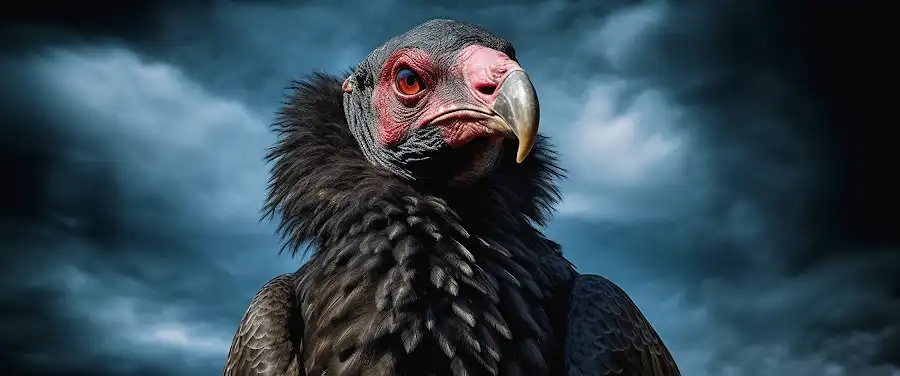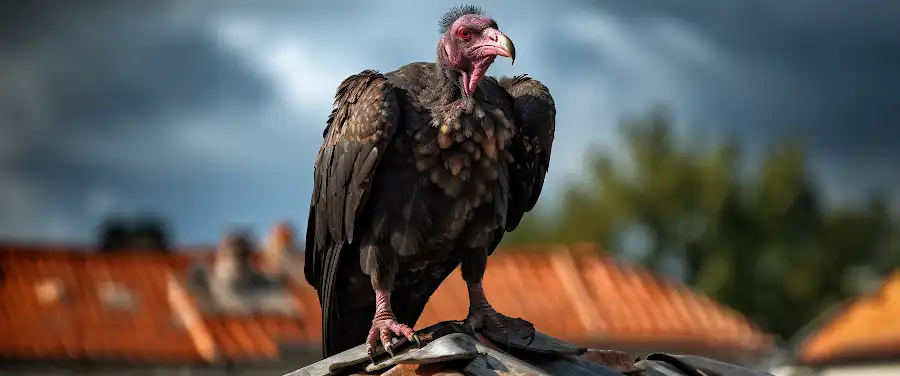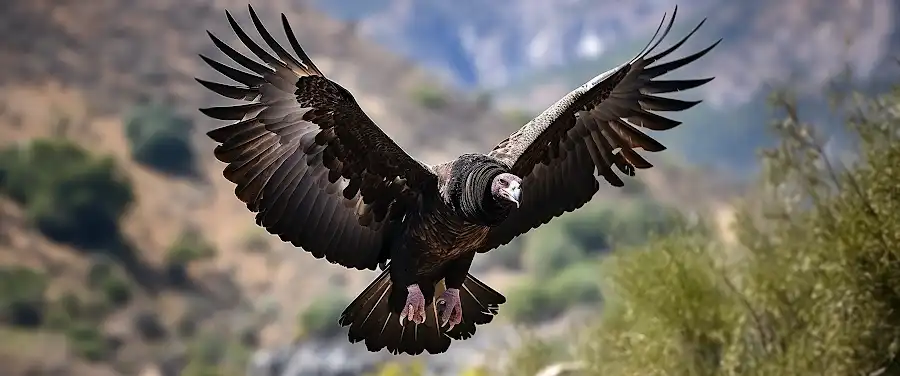
Have you ever glanced up at the sky and seen the grand silhouette of a bird swooping and swerving with an uncanny elegance? If you’re in Central Florida, chances are, you’ve witnessed the unique flight pattern of a turkey vulture. These birds, as fascinating as they may appear, have characteristics that are far less endearing. Being aware of the signs indicating the presence of these potential pests can enable early actions to safeguard your premises from becoming a vulture penthouse.
Known for those fierce red heads, broad wings, and strong beaks, turkey vultures are anything but dainty. These scavengers with a global presence are masters at adapting to diverse environments, requiring us to be vigilant and proactive. The majesty of these creatures does little to mitigate the annoyance they cause when your space turns into their preferred roosting spot. As unwanted guests, they certainly know how to overstay their welcome, leading to situations that require us to learn the art of recognizing an infestation.
Understanding the signs of a turkey vulture invasion is no small task but, by the end of this article, you will be more equipped to deal with it. We’ll unravel the common indicators of a turkey vulture problem, discuss their typical behaviors and provide you with the knowledge that is power in handling such situations. When we think of invading wildlife, rarely do we consider birds, but turkey vultures are part of a global phenomenon. It’s essential to shine light on the issue and understand what could attract these birds to your vicinity. After all, prevention is the best action one can take. More about turkey vultures and ways to handle them await you in the next segment. Hold onto your hats, because it’s about to get interesting – let’s dive in!
Understanding the Legal Status of Turkey Vultures

Turkey vultures, also known as turkey buzzards, are a common sight in the Central Florida region. They are critical scavengers in our ecosystem, consuming carrion or animal remains that may otherwise spread disease. However, for property owners, their increasing population can sometimes be a nuisance.
Legal Protection Status of Turkey Vultures
Interestingly, turkey vultures are not just common birds. They are formally recognized under the Migratory Bird Treaty Act, which provides them certain protections under federal wildlife laws. According to the U.S. Fish and Wildlife Service, turkey vultures cannot be killed or captured without a valid federal permit. This includes their nests, eggs or any part of their body.
Restrictions Related to Turkey Vulture Control and Expulsion
Despite their status as a nuisance, wildlife and public health regulations apply to handling turkey vultures. Specifically, you cannot legally trap, shoot, poison or harm these birds in any way. In fact, even dispersing too many birds at a time might be considered harassment. Alternative options can include installing deterrent devices or modifying habitat to discourage vulture presence. Always consult with a professional wildlife service before taking any actions.
| Laws and Regulation | Protection Measures |
|---|---|
| Migratory Bird Treaty Act | Can’t kill, capture, sell or purchase turkey vultures without a permit |
| Rookery Act | No destruction or disturbance of nesting sites |
| Florida Wildlife Code | Can’t harass, harm or kill turkey vultures |
Restrictions Related to Turkey Vulture Control and Expulsion
Violating these wildlife laws can lead to severe penalties. The Migratory Bird Treaty Act alone stipulates that violators could face up to $15,000 in fines per violation or even imprisonment. The Florida Wildlife Code also sets penalties for capturing, killing, or harassing turkey vultures. At the state level, penalties can range from small fines to months, or even years, in jail.
Have you noticed signs of a turkey vulture infestation on your property? Knowledge about their legal status, wildlife laws, and potential penalties for infringement is essential. You’ll be able to approach the situation with informed decisions, ensuring the safe and legal handling of these majestic birds.
In the next passage, you will discover how to identify indicators of a growing turkey vulture population in your surroundings. Stay tuned!
Identifying Indicators of a Turkey Vulture Infestation
Say hello to new (unwanted) neighbors – the Turkey Vultures. These bald-headed, black-feathered birds can pose significant threats to your property and the local ecosystem. How do you know when you’re dealing with a Turkey Vulture invasion in Central Florida? Let’s explore the explicit signs and subtle hints of a Turkey Vulture infestation.
One of the most glaring signs of a Turkey Vulture infestation is the visibility of these distinct creatures. Known for their bald, red heads and dark bodies, their presence is hard to miss. If you spot them circling and swooping down in your neighborhood, odds are, they’ve taken up residence.
Another key indicator includes environmental damage. Look for missing shingles or disturbed roofing materials. Also, any crushed plant life or signs of trees with peeling bark or broken limbs is a strong hint.
Moreover, pay attention to other animals. Pets might seem agitated or wildlife may flee due to the intimidating presence of these predatory birds.
Unveiling The Turkey Vulture Nesting Habits
Grasping the nesting habits of Turkey Vultures can provide valuable insights into whether your property has been infiltrated.
Unlike most birds, Turkey Vultures don’t build nests. Instead, they prefer to make use of existing structures such as cavities in trees, crevices in rocks, or the safe, hidden spaces of abandoned buildings. If you notice that these areas in your property seem to be occupied – get ready to blend in with your new feathered friends.
To present these details in an easy-to-digest format, here’s a quick reference table:
| Potential Turkey Vulture Nesting Site | Signs of Infestation |
|---|---|
| Cavity in Trees | Presence of droppings or feathers. Possible signs of damage to tree bark. |
| Rock Crevices | Feathers or droppings in or around the crevice. |
| Abandoned Buildings | Damage to roofing materials. Presence of droppings or feathers. |
Turkey Vultures and Their Breeding Patterns
Turkey Vultures have a unique breeding rhythm. They typically breed once a year, producing on average two offspring. The breeding season starts in late March and extends to June, so if you see these newcomers round this time, it might imply a breeding population.
Understanding the signs of a Turkey Vulture infestation, their nesting habits, and breeding patterns, you can take the necessary steps to control this nuisance and restore ecological balance. The Florida Wildlife Commission offers plenty of resources to help residents handle wildlife issues effectively.
The Environmental and Ecological Impact of Turkey Vultures

We can’t disregard the essential role of Turkey Vultures in our ecosystem, even though the mere mention might instigate an unsettling atmosphere. These large birds, often seen soaring in circles high above, are invariably on a mission to locate their next meal. Their ecological importance cannot be overstated: they serve as nature’s recyclers, cleaning up remains of dead animals, and consequently reducing the spread of diseases.
Nevertheless, nothing is ever completely black or white in the ecosystem. Despite the critical role they play, an undeterred population growth or an infestation of Turkey Vultures in a particular area, notably in Central Florida, can result in more harm than the intrinsic environmental benefits they offer.
The Double-Edged Sword of the Turkey Vulture’s Ecological Importance
Turkey Vultures can cover large areas in search of carrion, feasting on the carcasses of roadkill, and other animals that have died from natural causes or diseases. The cleanup they execute is not glamorous, but it is extremely useful in controlling the spread of bacterial and fungal growth that could have detrimental effects on human and animal health. To illustrate, the Center for Disease Control recognizes that scavengers like Turkey Vultures can help mitigate diseases like anthrax and rabies.
However, on the flip side, the Turkey Vultures’ feasting comes with adverse effects. When they consume a diseased animal, they can inadvertently help circulate and disseminate the disease across a wider radius. Thus, despite their positive impact in cleaning up after death, they can also be vectors of disease circulation.
Environmental Damage and Disease Circulation by Turkey Vultures
On the environmental front, Turkey Vultures can be destructive. Their acidic feces, often released in large volumes, can damage trees where they roost and other vegetation in the vicinity. A high concentration of Turkey Vultures in an area invariably leads to considerable environmental destruction.
Additionally, while Turkey Vultures generally curtail disease spread by consuming dead animals, they can, paradoxically, become agents of disease transmission. They are immune to many harmful bacteria and viruses and can carry these pathogens in their beaks and feet, spreading them to new locations. Diseases such as avian influenza, West Nile Virus, and salmonella have been found in Turkey Vultures.
To have a balance, a control is needed to prevent the adverse impact of Turkey Vulture infestations. Ideally, we want them to continue their natural recycling role without becoming destructive forces or disease disseminators.
When it comes to managing Turkey Vultures, determining the signs of an outbreak early-on and implementing effective prevention strategies is critical. This masterstroke will preserve their ecological benefits to Florida’s environment and the nation at large while also mitigating their potential downside impacts.
Conclusion
Knowing how to detect the signs of a Turkey Vulture infestation can be the key to conserving your serene Central Florida home. Let’s break it down: you’ve learned about the unmistakable bald red head, the winged ‘V’ formations, the carcass clean-ups – these are all the telltale signs to watch out for. But what’s next?
Effective control doesn’t mean outright war with these misunderstood misfits of nature. Yes, it’s true – Turkey Vultures can cause trouble, but remember, they play a significant role in our ecosystem, cleaning up carrion and keeping us disease-free. Having respect for these creatures is the first step to efficient management.
Don’t attack, control. Build deterrents, employ scare tactics like effigies, and try your best to make your space unattractive to them. Secure your trash bins, avoid leaving food outdoors, and cover up possible nesting areas.
Now, to wrap it up, let’s look the essentials. Overcome a ‘vulture vogue’ by recognizing symptoms early. Know your vultures, respect your vultures, but more importantly, learn how to deter them effectively.
Remember, we share our world with nature. Battaries will come, but tackling them with wisdom and respect is what sets us apart. Count every problem as an opportunity to learn more – about ourselves, others, and the world that surrounds us.




